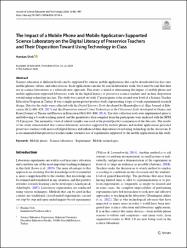The impact of a mobile phone and mobile application-supported science laboratory on the digital literacy of preservice teachers and their disposition toward using technology in class

View/
Access
info:eu-repo/semantics/openAccesshttp://creativecommons.org/licenses/by/3.0/us/Date
2024Metadata
Show full item recordAbstract
Science education at different levels can be supported by various mobile applications that can be downloaded for free onto
mobile phones, tablets, and other devices. Such applications can also be used in laboratory work, but it must be said that their
use in science laboratories is a relatively new approach. This study is aimed at determining the impact of mobile phone and
mobile application-supported laboratory work on the digital literacy of preservice science teachers and on their disposition
toward using technology in class. The study was carried out with 17 participants at the second-year level of a Science Teacher
Education Program in Turkey. It was a single-group pretest-posttest study, representing a type of weak experimental research
design. Data for the study were collected with the Digital Literacy Scale developed by Hamutoğlu et al. (Ege Journal of Education 18(1):408–429, 2017) and the Disposition toward Using Technology in the Classroom Scale developed by Gunuc and
Kuzu (Journal of Theory and Practice in Education 10(4):863–884, 2014). The data collection tools were implemented prior to
and following a 6-week teaching period, and the quantitative data compiled from the participants were analyzed with the SPSS
21.0 program. The parametric t-test of related samples was used in the pretest/posttest comparison of the data sets. The results
of the study demonstrated that science laboratory activities supported by mobile phones and mobile applications provided
preservice teachers with increased digital literacy and enhanced their disposition toward using technology in the classroom. It
is recommended that preservice teachers make extensive use of experiments supported by the mobile applications in this study.
Source
Journal of Science Education and TechnologyVolume
3Issue
6Collections
The following license files are associated with this item:


















